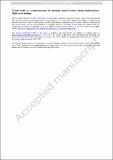| dc.contributor.author | Lonner, T. L. | |
| dc.contributor.author | Allred, A. R. | |
| dc.contributor.author | Bonarrigo, L. | |
| dc.contributor.author | Gopinath, A. | |
| dc.contributor.author | Smith, K. | |
| dc.contributor.author | Kravets, V. | |
| dc.contributor.author | Groen, E. L. | |
| dc.contributor.author | Oman, C. | |
| dc.contributor.author | DiZio, P. | |
| dc.contributor.author | Lawson, B. D. | |
| dc.contributor.author | Clark, T. K. | |
| dc.date.accessioned | 2023-11-13T15:40:01Z | |
| dc.date.available | 2023-11-13T15:40:01Z | |
| dc.date.issued | 2023-10-05 | |
| dc.identifier.uri | https://hdl.handle.net/1721.1/152937 | |
| dc.description.abstract | Abstract
Entry motion sickness (EMS) affects crewmembers upon return to Earth following extended adaptation to microgravity. Anticholinergic pharmaceuticals (e.g., Meclizine) are often taken prior to landing; however, they have operationally adverse side effects (e.g., drowsiness). There is a need to develop non-pharmaceutical countermeasures to EMS. We assessed the efficacy of a technological countermeasure providing external visual cues following splashdown, where otherwise only nauseogenic internal cabin visual references are available. Our countermeasure provided motion-congruent visual cues of an Earth-fixed scene in virtual reality, which was compared to a control condition with a head-fixed fixation point in virtual reality in a between-subject design with 15 subjects in each group. We tested the countermeasure’s effectiveness at mitigating motion sickness symptoms at the end of a ground-based reentry analog: approximately 1 h of 2Gx centrifugation followed by up to 1 h of wave-like motion. Secondarily, we explored differences in vestibular-mediated balance performance between the two conditions. While Motion Sickness Questionnaire outcomes did not differ detectably between groups, we found significantly better survival rates (with dropout dictated by reporting moderate nausea consecutively over 2 min) in the visual countermeasure group than the control group (79% survival vs. 33%, t(14) = 2.50, p = 0.027). Following the reentry analogs, subjects demonstrated significantly higher sway prior to recovery (p = 0.0004), which did not differ between control and countermeasure groups. These results imply that providing motion-congruent visual cues may be an effective mean for curbing the development of moderate nausea and increasing comfort following future space missions. | en_US |
| dc.publisher | Springer Berlin Heidelberg | en_US |
| dc.relation.isversionof | https://doi.org/10.1007/s00221-023-06715-5 | en_US |
| dc.rights | Article is made available in accordance with the publisher's policy and may be subject to US copyright law. Please refer to the publisher's site for terms of use. | en_US |
| dc.source | Springer Berlin Heidelberg | en_US |
| dc.title | Virtual reality as a countermeasure for astronaut motion sickness during simulated post-flight water landings | en_US |
| dc.type | Article | en_US |
| dc.identifier.citation | Lonner, T. L., Allred, A. R., Bonarrigo, L., Gopinath, A., Smith, K. et al. 2023. "Virtual reality as a countermeasure for astronaut motion sickness during simulated post-flight water landings." | |
| dc.contributor.department | Massachusetts Institute of Technology. Human Systems Laboratory | |
| dc.eprint.version | Author's final manuscript | en_US |
| dc.type.uri | http://purl.org/eprint/type/JournalArticle | en_US |
| eprint.status | http://purl.org/eprint/status/PeerReviewed | en_US |
| dc.date.updated | 2023-11-10T04:20:48Z | |
| dc.language.rfc3066 | en | |
| dc.rights.holder | The Author(s), under exclusive licence to Springer-Verlag GmbH Germany, part of Springer Nature | |
| dspace.embargo.terms | Y | |
| dspace.date.submission | 2023-11-10T04:20:48Z | |
| mit.license | PUBLISHER_POLICY | |
| mit.metadata.status | Authority Work and Publication Information Needed | en_US |
